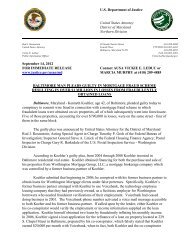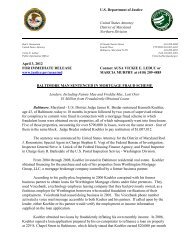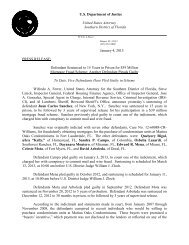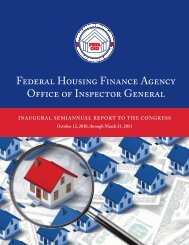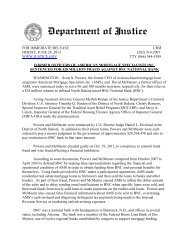FEDERAL
Sixth Semiannual Report to the Congress - Federal Housing ...
Sixth Semiannual Report to the Congress - Federal Housing ...
- No tags were found...
Create successful ePaper yourself
Turn your PDF publications into a flip-book with our unique Google optimized e-Paper software.
of government support, with many models also<br />
proposing government intervention during economic<br />
crises. 117<br />
Figure 20 (see page 55) highlights the major reforms<br />
and reformers.<br />
These proposals can be expected to grow more<br />
detailed as they progress since specific issues, such as<br />
establishing underwriting standards and managing<br />
risk, will need to be resolved. The following is<br />
intended to serve as a backdrop to deliberations about<br />
these more granular issues.<br />
Soundness: Lessons from the Past<br />
Our work has corroborated several lessons learned<br />
from the housing crisis: a sound housing finance<br />
market should include quality underwriting, robust<br />
risk management, and servicers who have incentives<br />
to align their interests with those of other market<br />
participants. Below, we review the historical basis for<br />
recognizing these lessons when reforming housing<br />
finance and then discuss some of our work that<br />
supports their importance.<br />
U.S. property values spiked from 2001 to 2006—an<br />
average of 12% each year. 118 As the boom proceeded,<br />
underwriting standards loosened and lenders<br />
increasingly approved higher mortgages for higherrisk<br />
borrowers who had little to no down payments,<br />
unverified incomes, and high debt. Associated credit<br />
risks spread throughout the financial system as<br />
these mortgages were bundled into publicly traded<br />
enterprise and private-label MBS. 119<br />
The dominant players in the secondary mortgage<br />
market before the boom, Fannie Mae and Freddie<br />
Mac took steps to maintain their market share during<br />
it. In 2001, the enterprises began buying—for their<br />
own investment portfolios—private-label MBS,<br />
many of which were collateralized by subprime<br />
mortgages. 120 According to the Government<br />
Accountability Office (GAO), the enterprises’<br />
holdings of private-label MBS increased rapidly from<br />
2003 to 2006. 121 This helped Fannie Mae’s assets<br />
and guaranteed mortgages grow from $1.3 trillion in<br />
2000 to $3.1 trillion in 2008, while Freddie Mac’s<br />
increased from $1 trillion to $2.2 trillion during the<br />
same period. 122<br />
As mortgage volume grew, the enterprises agreed to<br />
buy and guarantee higher-risk loans. 123<br />
Traditionally, the enterprises confined their businesses<br />
to lower-risk, prime loans. 124 But, during the<br />
housing boom, Fannie Mae, for instance, issued<br />
large numbers of variances, or exceptions, from its<br />
underwriting guidelines that permitted it to buy<br />
higher-risk products, such as zero down payment<br />
mortgages made to buyers with low credit scores and<br />
unverified income. 125<br />
In 2006, home prices leveled off, and the housing boom<br />
turned into a bust. 126 In 2007 and 2008, the enterprises<br />
began losing billions of dollars on their multi-trilliondollar<br />
MBS guarantees and investments. 127<br />
In the aftermath, many serious questions have<br />
arisen regarding the origination and securitization<br />
process. 128 Notably, during the summer of 2011,<br />
FHFA filed lawsuits against 18 large financial<br />
institutions, alleging violations of federal and state<br />
securities laws in connection with sales of privatelabel<br />
MBS to the enterprises. FHFA is pursuing fraud<br />
and other claims, alleging misleading disclosures<br />
about the quality of the mortgages that were used to<br />
securitize the MBS. FHFA’s complaints allege that the<br />
mortgage collateral securing the private-label MBS<br />
had materially different and higher-risk characteristics<br />
than described. 129<br />
Although there are different perspectives on which<br />
factors were most to blame for the housing crisis,<br />
it is generally agreed that contributing causes<br />
54 Federal Housing Finance Agency Office of Inspector General



